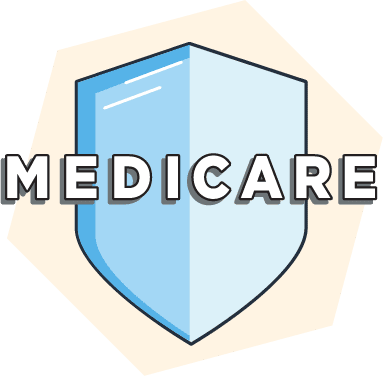Do You Have To Re-enroll in Medicare Annually?
In most cases, you do not need to re-enroll in Medicare annually. However, if you have Original Medicare (Parts A and B) with a separate Part D prescription drug plan or Medicare Advantage (Part C), certain exceptions might require you to manually re-enroll.
Exceptions may include the following scenarios:
- Medicare terminated its contract with your insurance provider.
- Your provider changed your plan’s coverage area, and it now excludes your location.
- Your plan unexpectedly withdraws from Medicare.
- Your provider does not renew its contract with Medicare for the next year.

You may choose to switch Medicare plans, even if you are not required to re-enroll if your current plan cannot meet your individual needs. You can only make changes during the following times:
- Open Enrollment Period (OEP) from Oct 15 to Dec 7
- General Enrollment Period from Jan 1 to March 31
- Special Enrollment Period (SEP) due to a qualifying life event
Table of Contents
How Does Medicare Re-enrollment Work?
Most Medicare renewals happen automatically for the next year after open enrollment, but some parts of Medicare require beneficiaries to take action if they seek changes to their plan.
Medicare Part A
Part A accounts for half of Original Medicare benefits, covering inpatient services like hospitalizations, hospice, and nursing home care. Most beneficiaries enjoy Part A benefits for $0 because you can avoid paying a premium if you paid into social security benefits for 10 years.
Manual renewal of Part A is unnecessary since Original Medicare auto-renews. You may, however, switch from Original Medicare to Medicare Advantage during open enrollment.
Medicare Part B
In tandem with Part A, Part B covers outpatient services, including routine and preventive care. Part B requires a set monthly premium, and both Part A and Part B include annual deductibles.
Original Medicare renews automatically in the fall with benefits continuing into the following year. You do not need to re-enroll in Part B but can add Part D or buy Medicare Advantage instead.
Medicare Part C (Medicare Advantage)
You can purchase Medicare Advantage from a private insurer instead of Original Medicare. Enhanced benefits usually include vision, dental, and hearing services, and many plans cover prescription drugs. Beneficiaries may choose to switch from Original Medicare to a Medicare Advantage Plan during the open enrollment window.
If you do choose to keep Original Medicare and you also have Part D prescription drug coverage, you may not enroll in a Medicare Advantage Plan at the same time. In addition to switching to Medicare Advantage from Original Medicare (without Part D), you may also switch Medicare Advantage Plans or drop Medicare Advantage for Original Medicare during open enrollment.
Medicare Part D
Medicare Part D covers prescription drugs, a feature not included in Original Medicare benefits. Beneficiaries must purchase a standalone Part D plan separately to cover prescriptions. All Medicare-eligible individuals should enroll in Part D or Medicare Advantage, which commonly covers prescription drugs, as soon as they turn 65 to avoid a lapse in drug coverage. You must choose between a Part D or Medicare Advantage Plan with drug benefits.
Beneficiaries may also incur a late enrollment fee if they delay signing up for Part D benefits. Part D plans automatically renew if changes are not made. During OEP, you may decide to do any of the following:
- Add Part D to Original Medicare
- Switch Part D plans
- Drop Part D for a Medicare Advantage Plan
Medigap
Medigap, also known as Medicare Supplement, helps beneficiaries pay common out-of-pocket expenses that Medicare does not cover. Medigap includes 10 different lettered plans, each with federally regulated benefits but varying prices, depending on statewide availability and insurance laws. Medigap addresses cost gaps in Medicare coverage but does not offer any additional medical or prescription drug benefits.
Beneficiaries of Original Medicare can purchase a standalone Medigap plan in their state to cover costs like copays, premiums, and coinsurance. Like Part D, Medigap only works with Original Medicare. You may not enroll in Medigap and Medicare Advantage at the same time. You may enroll in or switch Medigap plans during Medicare OEP.
What Is an Annual Notice of Change?

Medicare issues its Annual Notice of Change (ANOC) for Part D and Medicare Advantage Plans in September, giving beneficiaries plenty of time to consider making changes as necessary during open enrollment. The changes outlined in the ANOC go into effect the following January.
The ANOC notifies beneficiaries of changes to their current plan, costs, benefits, or networks. You should also receive an Evidence of Coverage (EOC) letter in the same booklet or around the same time as your ANOC. The EOC explains your existing plan’s comprehensive benefits, costs, and coverages, which remain in place unless you decide to make changes.
When Can You Re-enroll or Change Medicare Plans?
Medicare holds its annual open enrollment period from October 15—December 7. Anyone can make changes during the annual enrollment period. For example, you may need to drop or switch your Medicare Advantage or standalone Part D benefits at this time.
Outside of the open enrollment period, you must qualify for a special enrollment period to change your Original Medicare benefits, with or without Part D, or Medicare Advantage Plan. Qualifiers for a special enrollment period include moving out of your plan’s coverage area, losing your job, or having a baby. The special enrollment window is unique to your qualifying event.
In addition, there is the Medicare Advantage Open Enrollment period from 1/1 to 3/31 where members with Advantage plans can switch to another Medicare Advantage Plan with or without drug coverage, switch back to Original Medicare, or switch from one Medicare drug plan to another.
Putting It All Together
Medicare beneficiaries generally do not need to re-enroll unless they have Medicare Advantage or a standalone Part D plan in conjunction with their Original Medicare benefits. Some Medicare Advantage and Part D plans do atomically renew, so check with your insurer for details. Providers issue ANOCs ahead of the annual enrollment period to enable beneficiaries to review their Part D and Medicare Advantage Plans and make changes for the upcoming year.
You may not hold both Medicare Advantage and Part D prescription drug coverage concurrently. Enrollees in either of these programs can add, drop, or switch plans during Medicare Annual Open Enrollment, Oct 15-Dec 7, or Medicare Advantage Open Enrollment in January. You may also qualify for a special enrollment period for an event, such as a move, marriage, or loss of benefits, to make changes to your plan.
